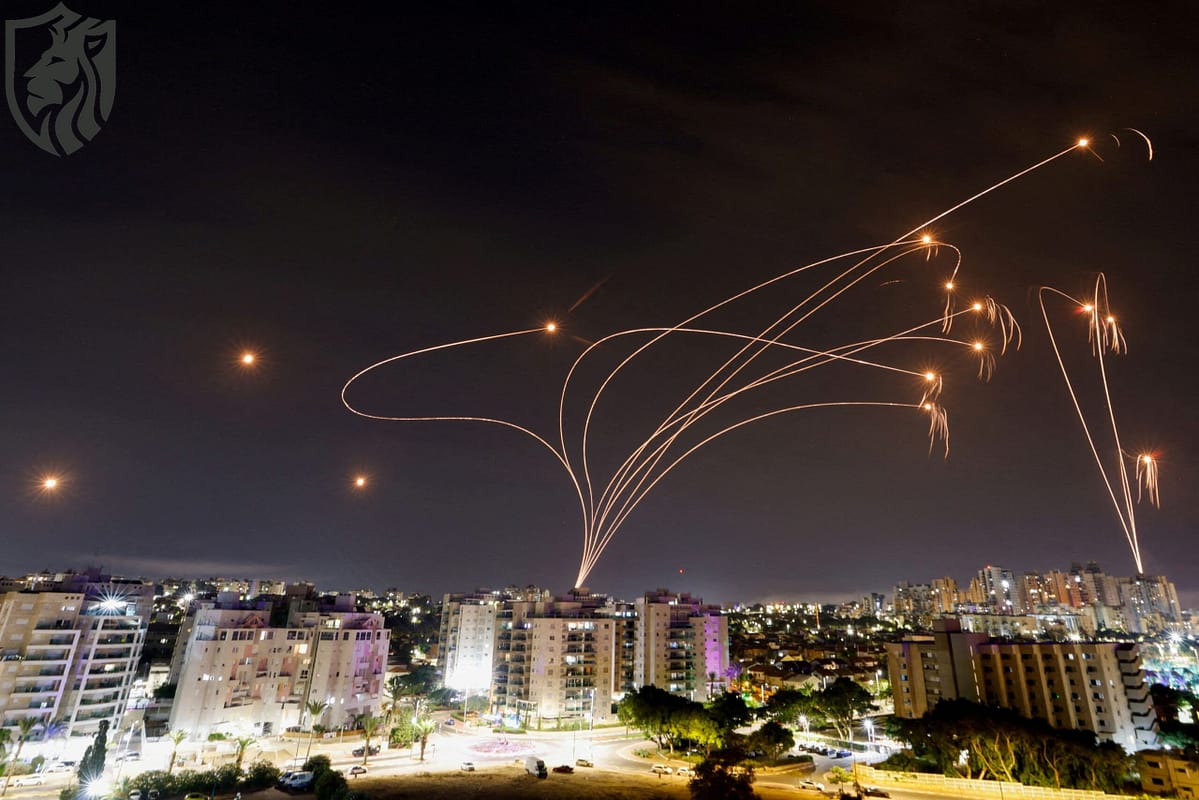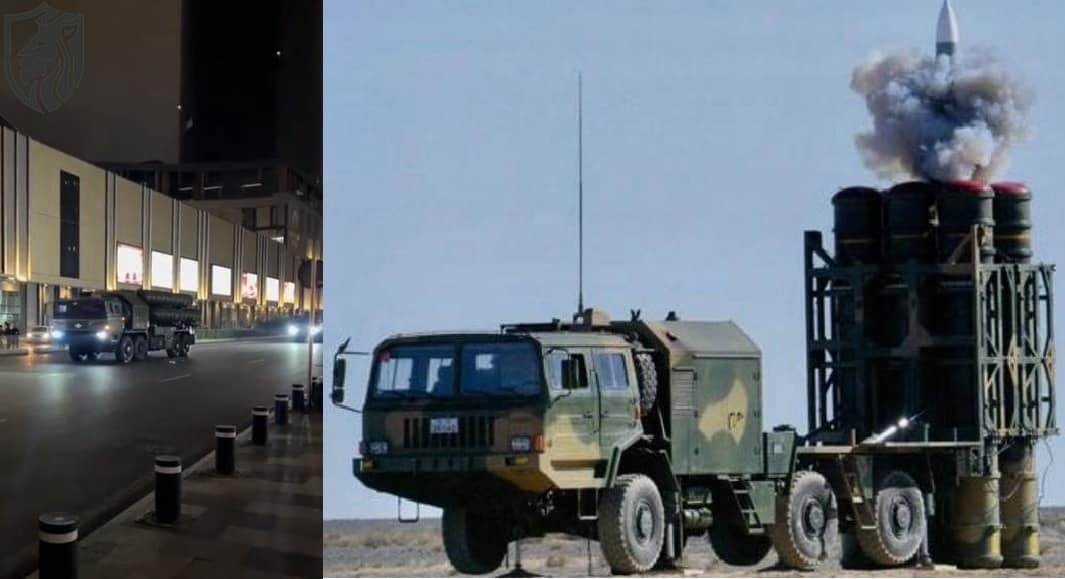
Iron Dome intercepting incoming projectiles.
On a dramatic June night in 2025, Iranian missiles lit up Israel’s skies, targeting military and civilian sites nationwide. The Israeli Defense Forces quickly activated their multilayered air defense system to neutralize the incoming threats.
Among these defenses, Iron Dome played a surprising role, despite its short-range design limitations. Despite its design to stop rockets from Gaza and Lebanon, Iron Dome intercepted 20 to 30 percent of ballistic missiles.
Analysts were stunned by Iron Dome’s unexpected success against threats it was never meant to counter. This performance highlights the misunderstanding of the system’s true capabilities in broader defense circles.
Originally deployed in 2011, Iron Dome protected Israeli towns from constant rocket fire by Hamas and Hezbollah. Rafael Advanced Defense Systems developed Iron Dome with substantial financial support from the United States.
Initially, the system aimed to intercept unguided rockets within 4–70 kilometers, like Qassams and Grads. Iron Dome uses the EL/M-2084 radar to detect and track threats in real time.
Tamir costs $50,000
Then, a control unit calculates missile paths and prioritizes which threats to intercept. Finally, the Tamir missile launches, designed to detonate near targets and destroy them with a precise blast.
Each Tamir costs about $50,000, but it only targets rockets bound for populated areas. This smart targeting preserves interceptors and reduces unnecessary use during heavy barrages. Iron Dome has maintained a documented success rate exceeding 90 percent since deployment.
Thanks to this system, Israel has saved countless lives and reshaped battlefield air defenses globally.

The early triumph of the system created did lay a basis, however, for a general public misperception that has persisted to the present day.
The general perception is that the Iron Dome is a panacea against any airborne threat, a perception that has been fed by its near-mythical status as Israel’s defense shield. The system was not intended to protect against ballistic missiles, however, which present a very different challenge.
In contrast to the low-speed, low-altitude rockets used by terrorist organizations, supersonic ballistic missiles, such as Iran’s Shahab-3 or Zolfaghar, travel at more than 5 Mach and on a high trajectory that may go beyond the Earth’s atmosphere.
Israel Aerospace Industries
With hundreds or thousands of kilometers of range and heavy or agile warhead delivery capability, they represent a threat beyond the original design parameters of the Iron Dome.
To counter these threats, Israel uses other systems: Arrow 2 and Arrow 3, produced by Israel Aerospace Industries and Boeing, intercept ballistic missiles in their terminal or midcourse stages, typically outside the atmosphere, and David’s Sling, co-developed with Raytheon, targets medium-range threats. Together, these form a multi-tiered system of defense, each designed for a particular threat profile.
The visibility of the Iron Dome partially explains the doubts about its effectiveness. As rockets are fired at Israeli metropolitan areas, photos of Tamir interceptors ascending through the sky fill the front pages, giving the false perception that nothing penetrates.
But in the case of ballistic missiles, as in Iran’s retaliatory strike against Israeli attacks on its nuclear and military installations, expectations always exceed real performance.
Critics view any missile that reaches its target as a failure, regardless of the complexity of neutralizing a coordinated, high-density attack. They overlook the remarkable advancements that have enabled Iron Dome to effectively neutralize threats beyond its initial design.
EL/M-2084 radar
Over the past decade, Rafael and its collaborators have been working on the Iron Dome system in the shadows, broadening its mission through a series of iterative upgrades that illustrate Israel’s proactive stance against anticipated regional threats.
The EL/M-2084 radar, with its highly sophisticated active electronically scanned array, has been software-modified to enable faster detection and tracking of high-speed targets.
These advancements enable the radar to distinguish between rockets’ computed flight paths and the complex flight paths of tactical ballistic missiles, which travel up to 300 kilometers.
The Tamir interceptor has been enhanced with modifications to its guidance and propulsion systems that enhance its maneuverability and allow it to engage threats in their terminal ranges just prior to contact.
These changes have given the Iron Dome a humble but advantageous capability to defend against some ballistic threats, i.e., those characterized by lower velocities or less complex trajectories, although they do not convert it into a dedicated anti-ballistic missile defense system.
Iron Dome
The most important advancement has been the incorporation of the Iron Dome into Israel’s overall air defense system. The system now operates with Arrow, David’s Sling, and American Navy resources that utilize SM-3 interceptors in real time.
The connected system, supported by advanced command-and-control technology, allows for flexible coordination, assigning each possible threat to the best interceptor.
For example, Arrow can intercept a ballistic missile at midcourse, whereas Iron Dome is designed to intercept those bound for lower altitudes. Artificial intelligence has enhanced this procedure by utilizing algorithms that analyze incoming trajectories and rank targets in milliseconds—a crucial response when dealing with multiple missile launches.
These developments mark a fundamental change in Israel’s defense posture, in that future conflicts will involve a combination of rockets, drones, and ballistic missiles from state players like Iran and non-state proxies like Hezbollah.
The evening that Iran fired back was an empirical validation of these technological innovations. As missiles fired from Iranian territory targeted Israel, the Israel Defense Forces’ air defense command faced an unprecedented challenge.
Shahab-3 missiles
The attack comprised a combination of Shahab-3 missiles with a range of up to 2,000 kilometers, in addition to short-range Zolfaghar variants that are experts at precision attacks.
The IDF asserted that its multilayered air defense system shot down around 80 to 90 percent of the missiles that targeted urban or strategically located areas, a statistic verified by independent analysts.
Most importantly, Iron Dome worked. Although originally developed as a rocket interceptor, the Iron Dome system successfully neutralized 20 to 30 percent of the ballistic missiles that reached Israeli airspace, particularly those aimed at cities such as Tel Aviv, Haifa, and Rishon LeZion.
This was not a flawless performance, I admit, but it demonstrated the system’s versatility, as it operated alongside Arrow and David’s Sling to minimize damage and casualties.
The attack caused minimal damage, three reported fatalities, and a reported 34 to 70 wounded, mostly in Rishon LeZion and the Galilee region.
Compared to the possible damage from an unprotected attack, the numbers show Israel’s defense’s success. However, for most analysts, the fact that some of the missiles actually hit their intended targets overshadowed the overall success.
Iron Dome’s effectiveness
Social media buzzed with skepticism as users shared images of bombed buildings to question Iron Dome’s effectiveness. However, critics ignored the complexity of the attack and misunderstood the mission of Iron Dome and its design limitations. The system targets specific threats within defined timeframes to prevent far worse destruction and loss of life.
To understand the recurring misconceptions regarding the effectiveness of the Iron Dome, one must look at the gap between public perception and technical reality.
The masses, flooded with news of missile attacks on TV, may not be able to distinguish between an ordinary Qassam rocket and the advanced Shahab-3. The system’s initial success created a near-fantastical impression of its capabilities, further exacerbating this confusion.
In 2011, the Iron Dome’s successful shooting down of rockets over Ashkelon was originally celebrated as a game changer, a defense system that would shield Israel from the most tenacious projectiles its enemies employed.
Over time, this perception morphed into an expectation that the system was capable of fending off any kind of threat, ranging from drones to hypersonic missiles.
When the Iron Dome fails to meet this unrealistic expectation, disappointment sets in, undermining the sophistication of its operational capacity.
Israeli public
A second problem is a lack of understanding by the Israeli public of the complex defense system. The Iron Dome is merely a single element of an integrated system designed to work in tandem with other technologies.
These technologies include the Arrow system, which utilizes hit-to-kill methods to destroy missiles at altitudes exceeding 100 kilometers, and David’s Sling, which targets threats ranging from short-range to long-range.
There is an envelope for each of the systems, and their overall effectiveness is dependent on precise coordination. During the Iran missile attack, Arrow would have intercepted missiles in the midcourse stage, while Iron Dome intercepted those coming in at lower altitudes.
In the absence of this information, one easily commits the fallacy of assuming the success or failure of the entire defense system to be credited to one system.
The psychological impact of missile strikes is particularly deep. A single explosion in a city like Tel Aviv can overwhelm news coverage, giving a sense of vulnerability.
People Focus
People tend to focus on the visible damage, such as smashed glass and destroyed buildings, rather than examining the dozens of missiles that failed to hit their target.

This narrow focus contributes to the exaggeration of Iron Dome’s success, overlooking the lives it has saved through intercepts. Despite multiple hits, only a few Iranian missiles caused damage, proving the system’s efficiency under extreme pressure.
Iron Dome’s recent upgrade shows how well the system adapts to evolving threats during crisis conditions. Israel’s defense leaders know Iran and Hezbollah are expanding. They have prioritized the constant evolution of Iron Dome’s capabilities.
Hezbollah now holds over 150,000 rockets, including precision-guided missiles supplied directly by Iran. To respond, Rafael is developing Iron Beam—a cost-effective laser system to destroy rockets and drones instantly.
Though not operational yet, Iron Beam promises lower costs and improved effectiveness during massed attacks. Therefore, Israel’s layered approach blends Iron Dome and Iron Beam for future high-volume threat scenarios.
Still, challenges remain—intercepting cheap rockets with expensive missiles is economically unsustainable in prolonged conflicts. Each Tamir missile costs $50,000, while some enemy rockets cost only a few hundred dollars.
Ballistic missiles
Ballistic missiles are also expensive, often necessitating the use of multiple interceptors to guarantee their destruction. The threat of saturation attacks—hundreds of rockets launched at once—remains a pressing concern for Israeli planners.
Iran’s hypersonic missiles also present dangers because of their speed and ability to evade existing defenses. Moreover, Iron Dome depends heavily on U.S. aid, adding financial and political complexity to its future.
Nevertheless, none of these issues diminish Iron Dome’s effectiveness or importance in Israel’s defense strategy. The system’s real strength lies in its constant adaptation and the brilliant minds behind its upgrades.
Nations like the U.S., India, and Ukraine have shown growing interest in buying Iron Dome systems. These countries understand the urgency of defending against a range of threats—simple rockets or advanced missiles.
Globally, Iron Dome offers a unique edge over systems like the Patriot, S-400, or HQ-9. Patriot interceptors are costly and less suited for rapid, dense rocket attacks.
Russia’s S-400
Despite its power, Russia’s S-400 has struggled to counter low-flying drones effectively during the conflict in Ukraine. China’s HQ-9 matches Patriot specs but lacks real-world, combat-proven effectiveness.
In contrast, the Iron Dome was built for short-range, low-cost defense but evolved to meet shifting threats. Its flexibility makes it a model for other nations countering asymmetric and unconventional attacks.
The June 2025 barrage confirmed that defense systems must continually adapt to survive modern warfare. Iron Dome proves no system is perfect, but layered defense strategies can manage complex threats.
Together, Iron Dome, David’s Sling, and Arrow highlight the power of interoperable systems working in unison. The U.S. could learn from Israel’s model as it confronts North Korean and Chinese missile threats.
Iron Dome’s journey is one of innovation forged through necessity and battlefield urgency. Although not a headline-making moment, its performance against ballistic missiles represents a major advancement.
Every successful intercept, for Israeli engineers and operators, signifies the accomplishment of a mission and the saving of one life. Critics who count only what gets through miss the quiet triumph of what was stopped mid-air.
References
- Rafael – Iron Dome
🔗 https://shorturl.at/kpBS8 - IDF – Air Defense Overview
🔗 https://shorturl.at/rzA37 - Missile Defense Advocacy – Iron Dome
🔗 https://shorturl.at/glpG5 - Defence News—Iran Missile Strike 2025
🔗 https://shorturl.at/vzLO1 - U.S. CRS – Iron Dome Funding
🔗 https://shorturl.at/fzIMW - Reuters—Israel Thwarts Iranian Attack
🔗 https://shorturl.at/qzMNO - Jerusalem Post – Iron Dome Intercepts
🔗 https://shorturl.at/pSUX4 - Defense Update – Iron Dome Upgrade
🔗 https://shorturl.at/duE39 - BBC – Iran-Israel 2025 Conflict
🔗 https://shorturl.at/jmIU6 - Haaretz – Post-Strike Analysis
🔗 https://shorturl.at/wEPX6









